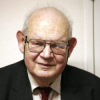Benoit Mandelbrot

Benoit Mandelbrot
Benoit B. Mandelbrot was a Polish-born, French and American mathematician with broad interests in the practical sciences, especially regarding what he labeled as "the art of roughness" of physical phenomena and "the uncontrolled element in life." He referred to himself as a "fractalist". He is recognized for his contribution to the field of fractal geometry, which included coining the word "fractal'", as well as developing a theory of "roughness and self-similarity" in nature...
NationalityFrench
ProfessionMathematician
Date of Birth20 November 1924
CountryFrance
The straight line has a property of self-similarity. Each piece of the straight line is the same as the whole line when used to a big or small extent.
If you look at a shape like a straight line, what's remarkable is that if you look at a straight line from close by, from far away, it is the same; it is a straight line.
There are very complex shapes which would be the same from close by and far away.
Some mathematicians didn't even perceive of the possibility of a picture being helpful. To the contrary, I went into an orgy of looking at pictures by the hundreds; the machines became a little bit better.
I was in an industrial laboratory because academia found me unsuitable
I was asking questions which nobody else had asked before, because nobody else had actually looked at certain structures. Therefore, as I will tell, the advent of the computer, not as a computer but as a drawing machine, was for me a major event in my life. That's why I was motivated to participate in the birth of computer graphics, because for me computer graphics was a way of extending my hand, extending it and being able to draw things which my hand by itself, and the hands of nobody else before, would not have been able to represent.
For much of my life there was no place where the things I wanted to investigate were of interest to anyone.
If you assume continuity, you can open the well-stocked mathematical toolkit of continuous functions and differential equations, the saws and hammers of engineering and physics for the past two centuries (and the foreseeable future).
A fractal is a mathematical set or concrete object that is irregular or fragmented at all scales.
Order doesn't come by itself.
The existence of these patterns [fractals] challenges us to study forms that Euclid leaves aside as being formless, to investigate the morphology of the amorphous. Mathematicians have disdained this challenge, however, and have increasingly chosen to flee from nature by devising theories unrelated to anything we can see or feel.
The extraordinary fact is that the first idea I had which motivated me, that worked, is conjecture, a mathematical idea which may or may not be true. And that idea is still unproven. It is the foundation, what started me and what everybody failed to **** prove has so far defeated the greatest efforts by experts to be proven.
Now that I near 80, I realize with wistful pleasure that on many occasions I was 10, 20, 40, even 50 years ahead of my time
Fractal geometry is not just a chapter of mathematics, but one that helps Everyman to see the same world differently.